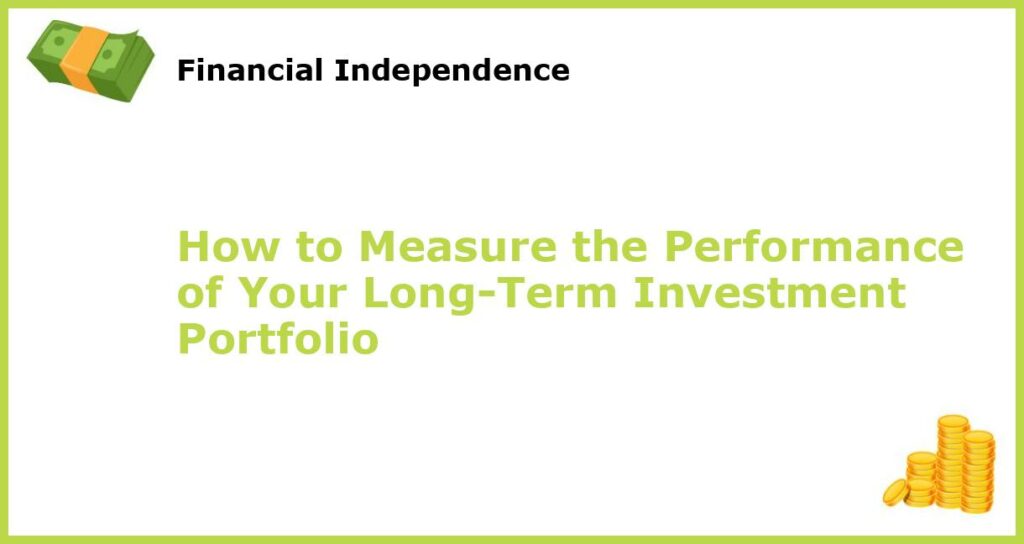Why measuring your long-term investment portfolio is crucial?

The goal of any investor is to make a profit on their investments. However, measuring the performance of your investment portfolio isn’t just important for the short-term. Monitoring its progress over an extended period can help you determine whether your investments are growing or not, and whether you are meeting your goals. By measuring the progress of your portfolio, you can make informed decisions that will ensure that you meet your objectives in the long term. Without regular portfolio monitoring, it is impossible to keep track of the progress of individual investments and your portfolio as a whole.
What to track when measuring your long-term investment portfolio?

Consider tracking relevant metrics, such as return on investment (ROI), risk tolerance, fees, asset allocation, and market trends. Return on investment (ROI) is the most apparent metric that investors track to determine their portfolio’s performance. Still, it is important to have a comprehensive view of your portfolio to determine any shortcomings, unrealized gains, or losses that you can take advantage of. Risk Tolerance is also an essential metric when assessing portfolio performance as it allows you to determine if your portfolio’s investments align with your risk profile. You should also track fees, as hidden fees such as fund expenses and brokerage commissions can significantly impact your returns over time. Having a clear understanding of how your investments are allocated into different asset classes in your portfolio is essential. It provides a comprehensive view of your portfolio, ensures a balanced range of returns and reduces the risks associated with over-relying on a particular asset class. Finally, tracking market trends is essential as it helps investors make informed decisions based on changes within the investment industry.
How to assess your portfolio returns?

The simplest way to track your portfolio returns is by measuring your gains or losses relative to your initial investment. Your ROI tracks these returns as a percentage of the total money you’ve invested. However, ROI is not the only measure of portfolio performance. Investors should also consider tracking unrealized gains and losses, which can impact the portfolio’s future returns. By monitoring the portfolio returns, investors can adjust their investment strategy or asset allocation in case of unexpected negative returns.
Tracking your portfolio’s risk tolerance
Risk tolerance is essential to consider when assessing your portfolio performance, as it helps investors balance their expected returns with the risks involved. Different investors have varying risk tolerance levels, depending on their investment goals, age, and financial circumstances. When measuring portfolio performance, ensure that your portfolio’s investments align with your risk tolerance levels. Having a portfolio with excessively high risk investments, for instance, will expose you to significant losses.
Why it is important to review fees when assessing portfolio performance
Hidden fees, such as fund expenses, commission fees, and other charges, can affect long-term investment returns significantly. Monitoring fees in your investment portfolio allows you to ensure that you obtain value for your money. When selecting investment products, investors should consider the total amount of fees paid over the investment’s life and ensure that the fees align with the expected long-term investment returns.
Assessing the impact of asset allocation in your investment portfolio
A well-diversified portfolio helps to minimize risks, stabilize returns during volatile market periods, and enhance long-term investment returns. Asset allocation allows investors to invest in different asset classes, such as stocks, bonds, mutual funds, and others, each with varying levels of risk and returns. By establishing and monitoring your asset allocation, you can avoid over-relying on specific asset classes and instead balance your investment risks against your expected returns.
Keeping tabs on market trends to measure your investments accurately
Monitoring financial market trends ensures that investors can capitalize on opportunities presented by the market without hurting their portfolio’s value. It provides a perspective on how different market events, such as interest rate changes, economic recessions, and policy developments, can impact your portfolio performance. By keeping tabs on financial market news, investors can evaluate the performance of their investments accurately, make informed decisions, and adjust their portfolio strategy accordingly to meet their long-term goals.
Important considerations when measuring the performance of your investment portfolio
Portfolios serve different investment goals and objectives. Before measuring your portfolio performance, evaluate your investment objectives and ensure that they align with your portfolio design. Review your progress towards meeting those objectives regularly and adjust your portfolio if necessary. Other major life changes, such as marriage, divorce, or retirement, might require an adjustment in the portfolio strategy. Always ensure that your portfolio comprises assets that align with your current situation.
Why diversification is the key to portfolio performance measurement success
Diversifying your portfolio with assets that have varying levels of risk protects your portfolio from any significant losses in a single area. It ensures that your portfolio can withstand any market changes or economic downturns, and you can continue to meet your financial goals. Diversification also provides a way of balancing risks against expected returns. By adding diverse assets to your portfolio, you enhance the potential for positive returns and reduce the risk of significant losses.
In Conclusion
Measuring the performance of your long-term investments is essential in making informed investment decisions. Tracking different metrics like ROI, risk tolerance, market trends, asset allocation, and fees ensures that you have a good understanding of your portfolio performance. With the right portfolio monitoring and management tools, you can build and track a portfolio that aligns with your investment goals and objectives. Regular reviews and adjustments of your portfolio will help you to reach your long-term investment goals successfully.







